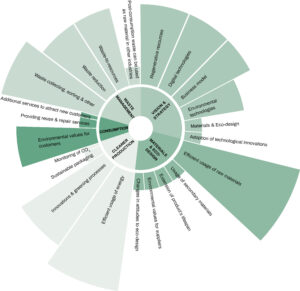More than half of the European Union countries are small open economies, and the smooth circular transformation of the entire EU significantly depends on these countries as well. According to the Kaunas University of Technology (KTU), Lithuania scientists, in today’s rapidly changing economic environment, their role in shaping global trade patterns and circularity issues deserves special attention.
A shift to a circular economy (CE) can be an answer to many issues caused by the prevailing linear economy model characterised by the intensive use of natural resources and the amount of waste produced. However, CE is an inherently complex, systemic, and multidimensional concept, and the integration of CE principles and practices varies across countries and industries.
She believes that the shift towards circularity should be based on a business model transformation as the validation of a circular business is not about the single sale, but about the life cycle of the product aligned with successful multi-actor collaboration among business partners, consumers, government and civic society.
Smaller can be smarter
In the book, published by Springer Cham, the authors explore the implementation of the CE model in small open economies in Europe. In addition to a theoretical review of data from various sources, the monograph provides practical insights by investigating case studies on the textile, furniture, and plastics industries in Lithuania.
She is convinced that the size of the economy is not the only determinant of productivity and growth. According to her, while small open economies (SOEs) have limited influence on global output levels and prices, they take advantage of their small size to make the most of their opportunities, thanks to their flexibility and speed of decision-making.
It is evident that there is a direct link between economic disparities among various small open economies within the EU and the implementation of circular economy practices. Justina Banionienė gives examples, that economically stronger SOEs tend to exhibit more green innovation and higher resource productivity, while weaker ones prioritize improving social conditions for employees. Besides, SOEs holding leadership positions in industries tend to implement more circular activities. This suggests that industry leadership plays a role in driving circular practices “Besides, small open economies with leading industrial positions are more likely to implement circular economy activities overall. This suggests that industrial leadership plays an important role in promoting circular economy practices,” adds the researcher.
Motivational factors to shift to circularity vary
According to Dagilienė, when moving towards circular business models, paradoxical contradictions arise for companies in different industries.
“Linear business model is validated when a certain level of sales of goods and services is sold. However, verifying a circular business model in practice is much more complicated. Modifying product ingredients or switching to biodegradable packaging are minor changes that lead to new eco-efficiency practices, but do not fundamentally change the prevailing business model principles,” explains Prof Dagilienė.
Moreover, pressure from brands, and global companies is seen to be more important than government regulation. This is due to the fact that many Lithuanian manufacturers are sub-contractors and need to adhere to high-level eco-standards in their value chains.
“The companies, operating on a biological cycle (e.g. food companies) focus on introducing technological solutions, however, in Lithuania, the majority of manufacturing companies are based on the technical cycle (e.g. furniture, plastics, textiles). Moreover, most of them are involved in a global network of value chains, so the main motivating factor for them to change their circularity approach is influenced by the requirements that are set by industry leaders,” says Varaniūtė.
The data shows that reverse logistics or green public procurement are not very relevant motivating factors for Lithuanian manufacturing companies to make more circular decisions in their operations. Varaniūtė believes that this may be due to excessive bureaucratic burdens.
Circular business models are often industry-specific and context-dependent
„From a circular economy point of view, Lithuanian textile manufacturers still lack eco-design solutions and novel business models orientated to product life-cycle extension,” says Dr Bruneckienė.
The furniture industry in Lithuania is highly technologically developed, with an increasing focus on digitalization. Business models embedded in the economics of Lithuanian furniture are orientated towards eco-efficiency through input material optimization and cleaner production processes. Although, among furniture manufacturers eco-design solutions are becoming more common, human-centred design, product integrity and sustainable materials issues still need to get attention. According to the researcher, the greatest challenge for this industry’s shift to circularity is closing the loop, as furniture manufacturers sell to large furniture retailers and do not contribute to the reverse value chains.
However, according to the KTU scientists’ research, the Lithuanian plastics industry is highly technological with sufficient innovation to implement the circular economy principles. The plastics sector has sufficient cooperation with other industries through well-developed reverse logistics aimed at closed loops, even though they sell their products to other manufacturers or retailers.
The book Circular Business Models in the Manufacturing Industry: Insights from Small Open Economies was published by Springer Cham on May 2, 2023, and can be accessed here.







